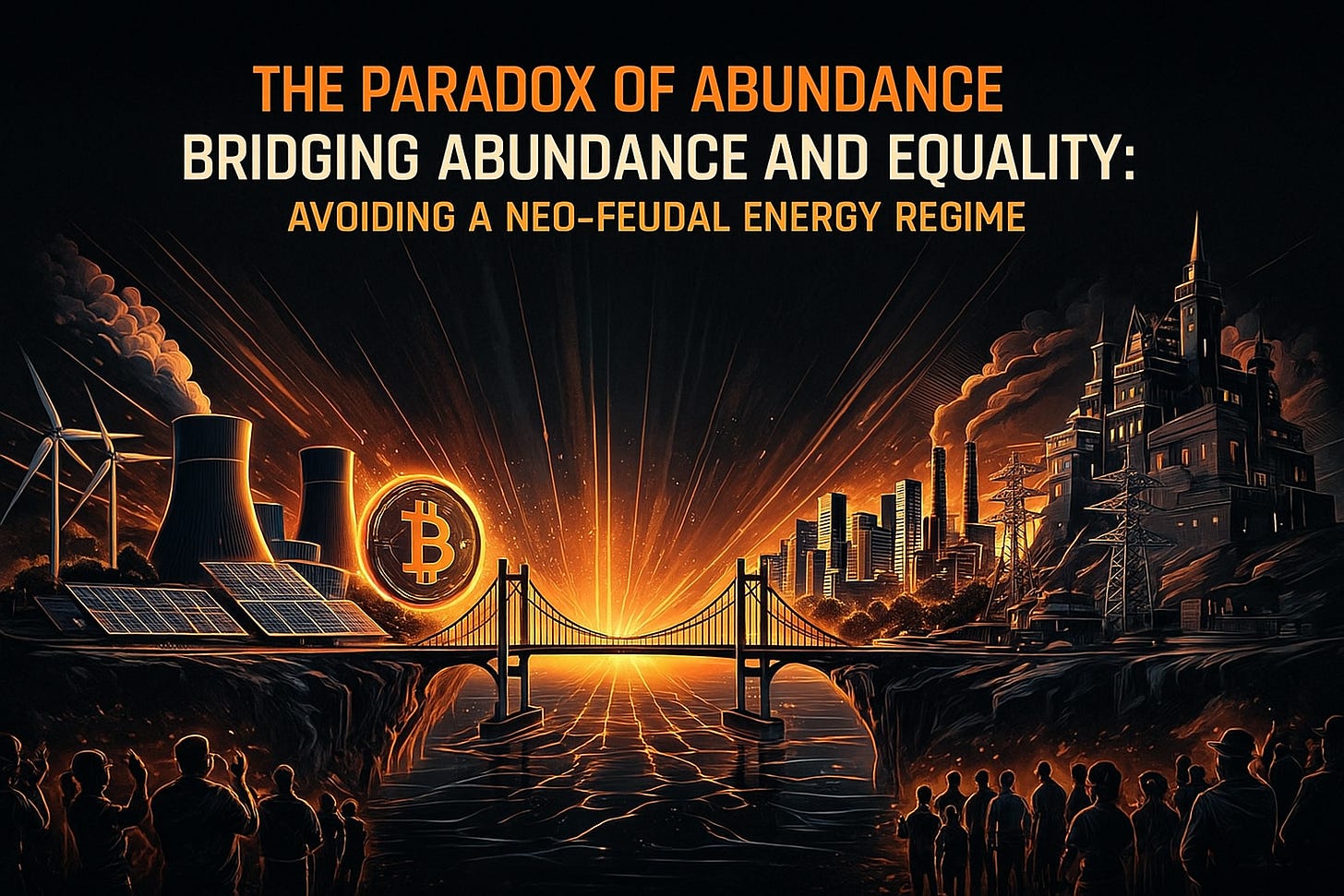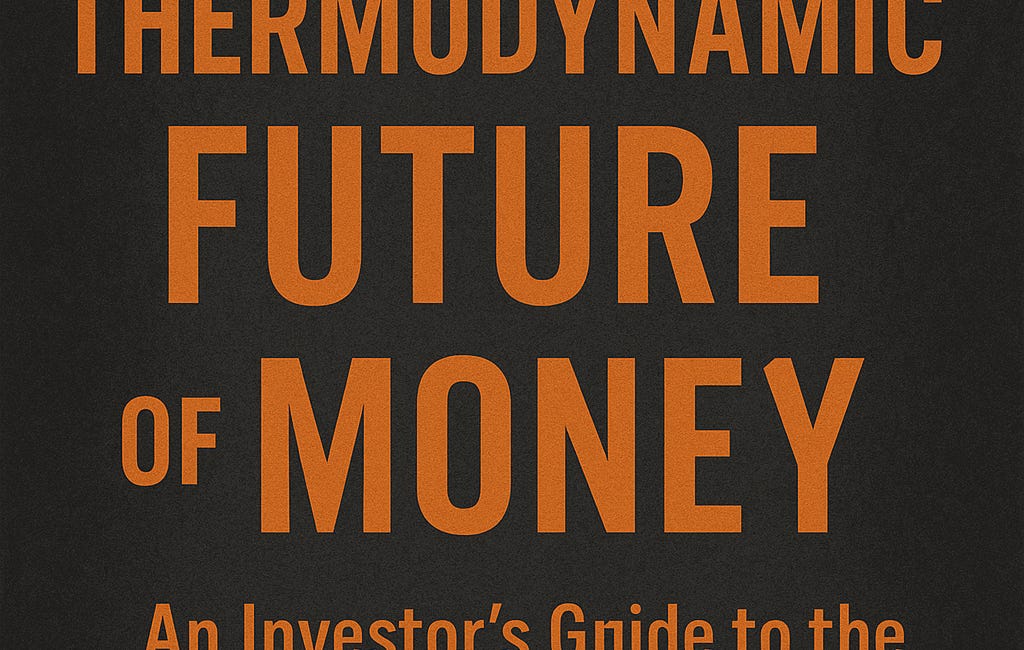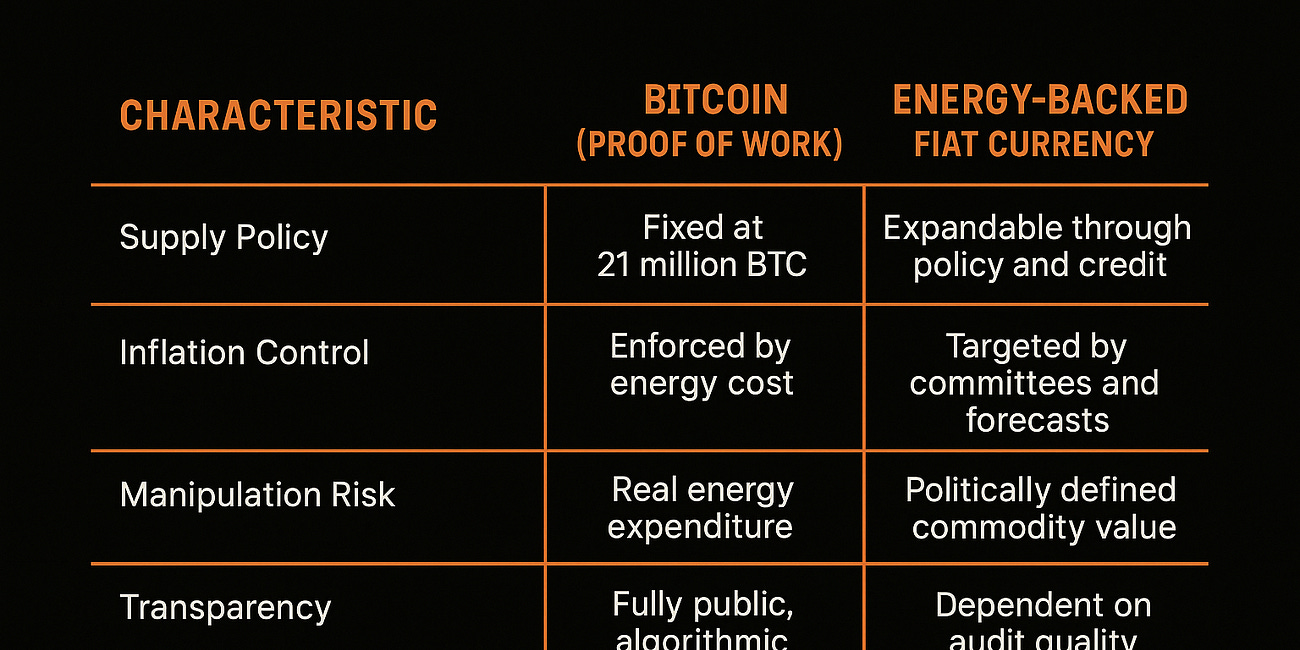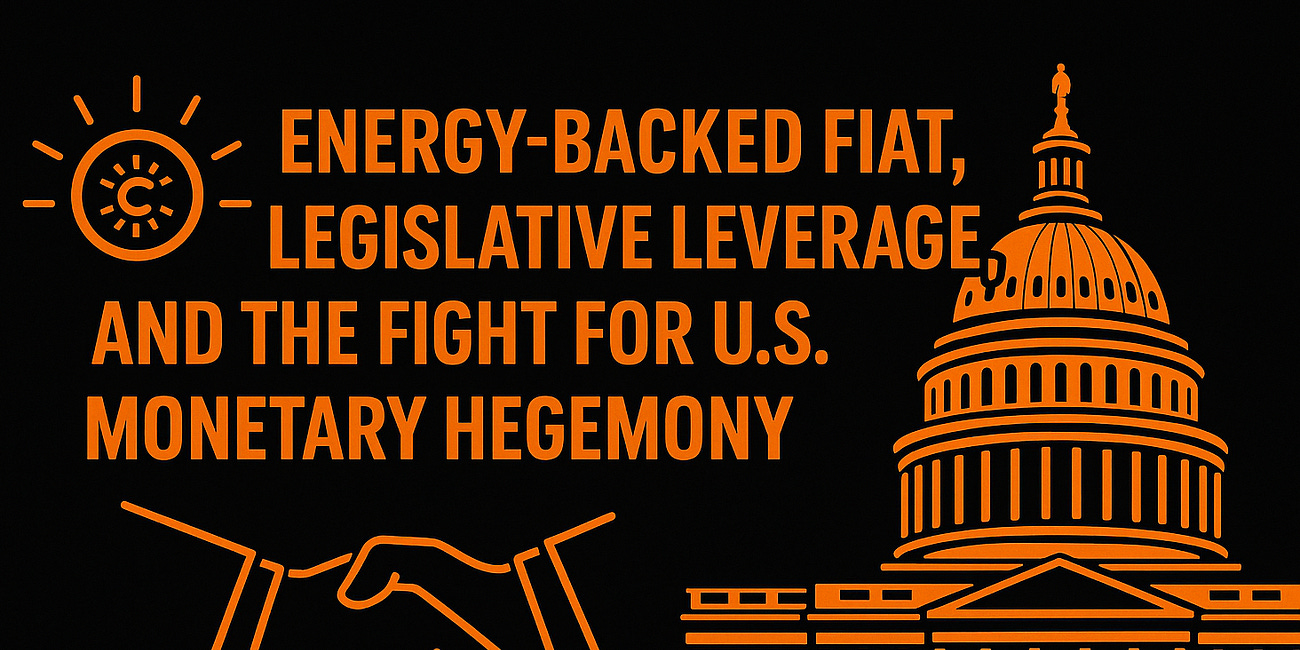Ch 5-The Thermodynamic Future of Money Series
Bridging Abundance and Equality: Avoiding a Neo-Feudal Energy Regime
The Paradox of Abundance
The transition to a thermodynamic economy, where value is measured in watts rather than promises, offers humanity the prospect of unprecedented prosperity. By mid-century (circa 2045-2055), energy abundance will be technically achievable through nuclear scalability, renewable synergies, and Bitcoin’s integration as a neutral settlement layer. Yet history reminds us that abundance alone does not guarantee equality. However, without intentional design, systems built on energy can reproduce the same hierarchies that fiat capitalism created, only with kilowatts replacing capital as the measure of power.
The challenge for policymakers, investors, and innovators is to ensure that this new order does not devolve into a neo-feudal energy regime, where ownership of energy-generation assets replaces ownership of money as the basis for privilege. To fulfill its promise, the energy-backed economy must combine efficiency with accessibility, pairing physics-based integrity with decentralized opportunity.
Why Energy-Backed Fiat Might Persist
Despite Bitcoin’s ascendance as the ultimate store of value, energy-backed fiat will likely endure on the rails of stablecoins and tokenized deposits. Governments require elasticity to respond to crises, invest in infrastructure, and manage welfare programs. Bitcoin enforces hard scarcity but states need controlled flexibility.
Properly designed, energy-referenced fiat systems can preserve social stability while reducing the moral hazard of unlimited printing. This should be our intended goal and minimum viable design criteria.
Several structural justifications explain why these systems will coexist:
Crisis Response and Liquidity Management
During natural disasters, wars, or pandemics, governments must expand liquidity quickly to fund reconstruction or defense. A strictly capped currency like Bitcoin lacks this functionality. Energy-backed fiat, pegged to expected or future generation, provides temporary elasticity without abandoning physical reference.
Infrastructure Investment and Transition Financing
The next thirty years will require trillions in nuclear, grid, and renewable infrastructure. Energy-pegged credits can securitize future power output, enabling states to issue debt backed by forthcoming capacity rather than abstract tax revenue. This aligns fiscal stimulus with tangible productivity.
Socioeconomic Bridging Function
An abrupt transition to a deflationary, energy-hard money could shock employment and liquidity. A hybrid fiat layer can soften adjustment costs while citizens adapt to new incentive structures. It serves as a bridge currency, cushioning volatility as society recalibrates toward abundance.
Administrative Necessity
Governments must still collect taxes, enforce contracts, and fund public goods. Maintaining a national unit of account (even one pegged to energy) ensures continuity of their governance while broader systems migrate toward Bitcoin-based settlement.
These justifications are pragmatic, not ideological. A more pleasant reality for all lives somewhere between the raw idealism of our Bitcoin ethos and the raw command and control temptations of the state. Tradeoffs don’t have to be zero-sum for the broader based personal liberty preservation of 8 billion people, but they will be required to scale a Bitcoin standard as the underlying globally honest settlement layer we have never had. Pragmatic compromises acknowledge that civilization cannot leap directly from inflationary debt-based monetary system to a perfectly thermodynamically balanced one overnight. A gradual, policy-anchored transition is required to sustain social order during technological and moonetary network transformation.
The Hidden Risk: Recreating Inequality Through Energy Concentration
The danger lies in how such hybrid systems are implemented. Without decentralization, energy-backed fiat could recentralize wealth and control under new guises. For the next century it would mean that instead of private banks and financiers pulling all of the strings, monopolistic energy corporations or state ministries could become the new issuers of privilege in the next faux-free market. After all without redundant access to consistent and affordable energy nothing works, including money.
Concentration of Energy-Generation Assets
Energy production (particularly nuclear and large-scale renewables) requires enormous capital. If access remains confined to governments or a few large conglomerates, they will dominate monetary issuance. Ownership of reactors or grid nodes becomes equivalent to controlling the mint. This structure risks repeating the feudal dynamic of the industrial age: a small elite owns the infrastructure, while the majority rents access to power and currency. It may be obvious, but if we don’t begin intentionally design against this outcome today, then we are sadly hurdling ourselves directly into it at record speed.
At the same time our inertia and technology increases the probability of this outcome, AI gives us the opposite side of the dystopian coin, allowing us to run immediate and unparalleled scenario builders to help provide previously unconsidered ways to architect this beneficial destiny and move our collective humanity towards it.
Asymmetry of Energy Distribution
Regions rich in low-cost energy, such as those with hydro or geothermal zones, will accumulate disproportionate wealth. Energy-poor nations, unable to generate a surplus, will depend on imports priced in energy-backed credits. The result could be a global hierarchy where “surplus states” function as energy landlords and “deficit states” as perpetual tenants.
Policy Manipulation and Soft Inflation
Even with energy pegs, governments retain the ability to redefine equivalence. By altering conversion ratios (declaring, for instance, that one credit equals a lower-quality watt-hour) they can inflate quietly. This introduces “semantic inflation,” a rebranding of dilution under technical language. This slight of hand must be resisted. We need to find ways to inspire and educated our broader electorate again with the role we all play and accountability we all share in mitigating more of the same from our policy makers and innovators.
Data and Surveillance Control
Energy-backed money systems rely on digital measurement: smart meters, carbon trackers, and consumption analytics.
Centralized management of these data flows most likely would enable pervasive surveillance. Citizens’ spending patterns, energy use, and even behavioral profiles could be algorithmically tied to credit access, eroding privacy and autonomy. THIS IS NOT GOOD. THIS IS ALSO NOT NECESSARY.
If left unchecked, these dynamics could produce a technocratic caste system where social mobility depends on access to energy data networks rather than individual merit. The very technologies intended to free humanity from scarcity could become tools of subtle subjugation. I am calling out these probable scenarios in this 5-part report to illuminate the danger and course we are on, so that more of us can help “pause” and “think” before we blindly accept the propoganda or rhetoric that these things are necessary for our safety.
Learning from the Fiat Era
The past century offers cautionary parallels. The fiat system, designed to democratize finance, devolved into a mechanism of wealth concentration through debt leverage. The centralization of credit creation by the Federal Reserve System of banks and monetary authorities amplified inequality, allowing those closest to the money spigot to accumulate assets before inflation diluted purchasing power. (read my prior post on The Cantillon Effect here)
An energy-backed fiat system could repeat this cycle under new physics. Those closest to the energy spigot—utility executives, regulators, and corporate intermediaries—would issue credits and capture seigniorage. The result would be energy aristocracy: a narrow class profiting from control of the grid, while citizens remain dependent on state-issued energy rationing.
Avoiding this outcome requires decentralized verification and distributed ownership. The integrity of thermodynamic money depends not only on energy’s measurability but also on its accessibility.
Pathways to Democratizing the Energy Base
A balanced thermodynamic economy must blend efficiency with equity. Four design principles can help prevent concentration while sustaining stability.
1. Decentralized Energy Auditing
Every nation’s energy reserve data—generation, consumption, and storage should be published on transparent, open-source blockchains. Independent validators, not political appointees, must verify output. This prevents falsified accounting and ensures that energy-pegged currencies reflect genuine capacity.
2. Programmable Monetary Limits
Smart contracts should hard-code issuance ceilings tied to verified watt-hour production. Once physical capacity thresholds are reached, issuance halts automatically. This eliminates discretionary expansion while retaining controlled elasticity during emergencies.
3. Distributed Ownership of Energy-Generation Assets
Governments and investors can foster community-owned microgrids, DAO-style cooperatives, and tokenized renewable projects. Citizens become shareholders in local energy production, receiving dividends in the form of energy credits or Bitcoin. Ownership of the energy base decentralizes income streams transforming passive consumers into active participants.
4. Dual-Layer Settlement Architecture
Domestic transactions can operate on energy-backed fiat rails, while cross-border settlements finalize on Bitcoin’s base layer. This dual system ensures that nations cannot secretly inflate without market detection, as Bitcoin settlement provides external auditing of monetary honesty.
Implementing these principles creates a self-regulating equilibrium where efficiency and fairness coexist.
Energy, Equality, and Human Purpose
Technology can eliminate scarcity, but it cannot manufacture meaning. As energy abundance grows, the next frontier of inequality will be a shift to psychological and spiritual scarcity rather than material as the cost of production (through AI) becomes near zero and the search for ‘meaning’ hits an all-time high. Those who understand how to navigate abundance (how to create, contribute, and connect) will thrive. Those who remain conditioned by scarcity mentalities may experience paralysis despite having plenty.
Peter Diamandis has written that the coming decades will challenge humanity not through famine or war but through the crisis of purpose that abundance creates.
When survival no longer drives behavior, meaning must take over. The challenge is no longer generating wealth but distributing opportunity that delivers on fulfillment.
In an energy-based economy, value creation shifts from extraction to creativity. This is a tremendously positive promise to lean into.
The entrepreneurs and investors who combine technological mastery with moral imagination will define the next golden age. True prosperity arises when thermodynamic integrity supports human flourishing, not merely when it enriches balance sheets.
The Moral Physics of Wealth
Bitcoin’s proof-of-work model introduces an implicit moral framework: honesty requires cost.
Extending this ethic to society means that prosperity must remain correlated with contribution. Energy abundance does not justify entitlement; it amplifies responsibility.
In a thermodynamic civilization, the greatest inequality will not be in resources but in wisdom, which is our ability to deploy energy toward meaningful outcomes. Leaders who recognize this will invest not only in infrastructure but in education, ethics, and emotional intelligence. These investments transform raw power into civilization.
The next generation of wealth creators will be stewards rather than extractors, guiding humanity through the transition from survival economics to purpose economics. Their legacy will not be measured in watts owned but in lives empowered.
Designing Incentives for Equitable Abundance
To ensure that energy-backed systems uplift rather than oppress, incentive design must reward decentralization.
Microgrid Tokenization: Local communities can tokenize renewable projects, allowing residents to invest directly in solar or wind production and earn returns in Bitcoin or credits.
Open-Access Infrastructure Funds: Governments and institutions can establish public-private funds to finance distributed generation, ensuring that returns flow to citizens rather than monopolies.
Energy Dividends: Surplus generation can be rebated to citizens as universal energy income—measured not in cash but in watt-hour credits spendable on local goods or converted to Bitcoin.
Transparent Governance: Policy frameworks should require that any change in energy-money parity or issuance rules be auditable by the public, minimizing corruption and moral hazard.
These mechanisms embed fairness into the thermodynamic fabric of the new economy. They transform energy from a monopoly into a commons of opportunity.
The Investor’s Role in Ethical Transition
Investors occupy a pivotal position in shaping whether energy finance becomes inclusive or extractive. Capital allocation determines the moral architecture of the future. Allocating exclusively to centralized utilities or speculative tokens risks perpetuating inequality. Funding decentralized infrastructure, cooperative ownership, and educational initiatives ensures that returns compound across society.
In practice, this means supporting ventures that:
Expand access to nuclear and renewable in developing markets.
Create open verification systems for global energy data.
Integrate Bitcoin settlement with transparent, community-scale power grids.
Build human capital (education, resilience, self-worth, and leadership) to navigate abundance.
Profit and purpose need not be in conflict. When aligned with thermodynamic integrity, they reinforce one another. The greatest arbitrage of the 21st century will not be between fiat and Bitcoin, but between extraction and stewardship.
The Governance of Freedom
As programmable energy money emerges, governments will face a defining choice between control and trust. One path leads to surveillance and digital serfdom—an efficient but authoritarian system where freedom is rationed in watts. The other leads to accountable autonomy, where open verification and distributed ownership preserve individual liberty within physical constraints.
Bitcoin’s role is to guarantee that base-layer honesty remains non-negotiable. Bitcoin anchors governance to physics, ensuring that no authority can rewrite its scarcity. Around that foundation, societies are free to experiment with forms of fiat and credit as long as they remain transparent.
Freedom, in this framework, is not the absence of constraint but the alignment of constraint with truth. A civilization that respects both will achieve durability without oppression.
The Endgame: A Civilization in Equilibrium
By 2050, humanity could inhabit and enjoy a world where energy and information flow freely, where money reflects physics, and where wealth creation aligns with planetary limits. However, this equilibrium will require moral evolution in parallel to technological progress.
The future cannot be built solely on efficiency; it must rest on empathy.
Thermodynamic finance must be matched by thermodynamic ethics—a recognition that power without purpose destroys itself every time.
The same forces that can create abundance can also entrench tyranny if guided by fear rather than vision. Bitcoin, nuclear power, and AI are tools and weapons. Whether they liberate or enslave depends on how society wields them. Investors, entrepreneurs, and citizens alike must insist that energy abundance translates into human flourishing rather than hierarchy. The energy-rich world must also be rich with dignity.
Conclusion
In these last five chapters I have done my best to succinctly but robustly cover how the The thermodynamic (future of money) era offers a once-in-a-civilization opportunity to reconcile economics with physics and prosperity with purpose. This is far from complete or exhaustive, and yet serves as a critical conversational thought piece for further input, discussion, debate, and solution-oriented design. I welcome you all to comment, weigh in, or run with this within the networks of influence you may belong.
If designed wisely, an energy-backed monetary system settled on the Bitcoin network can stabilize inflation, democratize capital, and unlock universal abundance. If designed poorly, it could ossify inequality and transform digital networks into invisible chains.
Avoiding that fate requires vigilance, transparency, and values-driven innovation. Bitcoin provides the incorruptible foundation, policy must provide the fairness. Together, they can forge a civilization where wealth and energy circulate freely, constrained only by the laws of nature and the ethics of humanity.
In the final analysis, the great question of our time is not whether energy will replace money, but who will own the means of energy creation and to what end.
The answer to this question will determine whether the 21st century becomes another age of empire or the first truly decentralized renaissance in humanity.
The future of money blueprint is clear:
anchor money in physics
distribute ownership, and
cultivate wisdom.
The rest is execution, ethics, and our collective will to live better tomorrow than we do today.
~Chris J Snook
All Previous Chapters in the Series:
Chapter 3: The Thermodynamic Future of Money Series
Moving From Policy Scarcity to Physical Scarcity
Chapter 5 Endnotes
1. Commodity-Backed Money vs. Fiat Money: A Deep Comparison — Lumio App https://yourmoney.lumio-app.com/commodity-backed-money-vs-fiat-money/
2. Energy as the New Currency (Part I of II) — illuminem https://illuminem.com/illuminemvoices/energy-as-the-new-currency-part-i-of-ii
3. Fiat Money: What It Is, History, Advantages and Disadvantages — Poems Singapore https://www.poems.com.sg/glossary/financial-terms/fiat-money/
4. Fiat Money: Meaning, Advantages, and Examples — Geeks for Geeks https://www.geeksforgeeks.org/finance/fiat-money-meaning-advantages-disadvantages-and-examples/
5. Fiat Money Explained: Benefits, Risks, and Global Examples — Investopedia https://www.investopedia.com/terms/f/fiatmoney.asp
6. Fiat Money: Pros and Cons Explained — ECOS Mining Blog https://ecos.am/en/blog/fiat-money-pros-and-cons-explained/
7. Energy-Backed Money vs. Gold Standard vs. Fiat Currency — EnergyBackedMoney.com https://www.energybackedmoney.com/chapter7.html
8. Fiat Money: Definition, Examples, Pros and Cons — SmartAsset https://smartasset.com/investing/what-is-fiat-money
9. Energy-Backed Currency — Jeff Eisen, Ph.D.https://drjeffeisen.com/2011/11/21/energy-backed-currency/
10. Fiat Money – Corporate Finance Institute https://corporatefinanceinstitute.com/resources/economics/fiat-money-currency/











